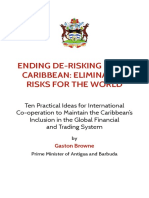0 ratings0% found this document useful (0 votes)
8 viewsNon Resident Indian (NRI)
Non Resident Indian (NRI)
Uploaded by
PARUL BOBALThe document defines key terms related to foreign investment in India - Non Resident Indian (NRI), Person of Indian Origin (PIO), and Overseas Citizen of India (OCI). It discusses opportunities for NRIs to invest in real estate development projects and housing, as well as the tax benefits available through Section 80-IB of India's Income Tax Act. Overall, the booming Indian economy, IT sector, policies, and middle class represent opportunities for NRIs to invest.
Copyright:
© All Rights Reserved
Available Formats
Download as PPT, PDF, TXT or read online from Scribd
Non Resident Indian (NRI)
Non Resident Indian (NRI)
Uploaded by
PARUL BOBAL0 ratings0% found this document useful (0 votes)
8 views9 pagesThe document defines key terms related to foreign investment in India - Non Resident Indian (NRI), Person of Indian Origin (PIO), and Overseas Citizen of India (OCI). It discusses opportunities for NRIs to invest in real estate development projects and housing, as well as the tax benefits available through Section 80-IB of India's Income Tax Act. Overall, the booming Indian economy, IT sector, policies, and middle class represent opportunities for NRIs to invest.
Original Description:
nri
Original Title
nonresidentindiannribala-120813031613-phpapp01
Copyright
© © All Rights Reserved
Available Formats
PPT, PDF, TXT or read online from Scribd
Share this document
Did you find this document useful?
Is this content inappropriate?
The document defines key terms related to foreign investment in India - Non Resident Indian (NRI), Person of Indian Origin (PIO), and Overseas Citizen of India (OCI). It discusses opportunities for NRIs to invest in real estate development projects and housing, as well as the tax benefits available through Section 80-IB of India's Income Tax Act. Overall, the booming Indian economy, IT sector, policies, and middle class represent opportunities for NRIs to invest.
Copyright:
© All Rights Reserved
Available Formats
Download as PPT, PDF, TXT or read online from Scribd
Download as ppt, pdf, or txt
0 ratings0% found this document useful (0 votes)
8 views9 pagesNon Resident Indian (NRI)
Non Resident Indian (NRI)
Uploaded by
PARUL BOBALThe document defines key terms related to foreign investment in India - Non Resident Indian (NRI), Person of Indian Origin (PIO), and Overseas Citizen of India (OCI). It discusses opportunities for NRIs to invest in real estate development projects and housing, as well as the tax benefits available through Section 80-IB of India's Income Tax Act. Overall, the booming Indian economy, IT sector, policies, and middle class represent opportunities for NRIs to invest.
Copyright:
© All Rights Reserved
Available Formats
Download as PPT, PDF, TXT or read online from Scribd
Download as ppt, pdf, or txt
You are on page 1of 9
Introduction
Non Resident Indian (NRI)
The term NRI has not been defined in FEMA,
1999. However Regulation 2(vi) of the FEMA
(Acquisition & Transfer of Immovable
Property in India) Regulations 2000 defines
the same as follows:
An NRI is a person resident outside India who
is a citizen of India or is a Person of Indian
Origin
Person of Indian Origin (PIO)
A PIO has been broadly defined as a citizen of any
country other than Bangladesh or Pakistan [certain
Regulations also include Sri Lanka, Afghanistan,
China, Iran, Nepal or Bhutan] if:
at anytime he has held an Indian passport; or
If he or either of his parents or grand parents was a
citizen of India by virtue of Constitution of India of
the Citizenship Act 1955; or
the person is a spouse of an Indian citizen or a person
referred to in sub-clause (a) or (b) above.
Overseas Citizen of India (OCI)
An OCI is a foreign national, who was eligible to
become a citizen of India on 26.01.1950 or was a
citizen of India on or at any time after 26.01.1950 or
belonged to a territory that became part of India after
15.08.1947 and his/her children and grand children, is
eligible for registration as an Overseas Citizen of
India (OCI).
However, if the applicant had ever been a citizen of
Pakistan or Bangladesh he/she will not be eligible for
OCI
Legal Counseling Issues
Opening of a Bank Account: Foreign nationals resident but
not permanently resident in India are permitted to maintain
and operate bank accounts in India only with authorised
dealers.
Acquisition, Management & Transfer of Immovable
Property: Section 6(5) of FEMA 1999, provides that a person
resident outside India can hold, own, transfer or invest in
Indian currency, security or any immovable property situated
in India if such currency, security or property was acquired,
held or owned by such person when he was a resident in India
or inherited from a person who was a resident in India.
NRIS INVESTMENT
Investment by Non Resident Indians is allowed in all
categories.
Earlier, only the NRIs were permitted to invest in
Housing and Real Estate sectors, RBIs Circular
known as Press Note 2 of 2005 dated March 3, 2005
and Press Note 4 of 2006 dated February 10, 2006
have vastly widened the field and opened the
floodgates for FDI in townships, housing,
infrastructure and construction/ development
projects.
Opportunities lining up for NRIs..
Direct FDI allowed in residential townships of more than 25
acres and in construction with approval for projects offering
built-up area of more than 50 thousand square meters.
Direct and automatic approval for IT park and hotel
investments.
Foreign and domestic venture capital investment in real estate
allowed with prior approval.
Within special economic zones, akin to Foreign trade zones in
the USA , developments, free capital and dividends allowed
with many specific tax exemptions on profits (5 to 10 years),
and local taxes.
Accruing Income Tax Benefits
Section 80-IB (10) of the Income Tax Act, 1961 exempting the entire
income from specified housing projects from income tax invites FDI and
NRIs to rush to India.
Section 80-IB (10) exempts an industrial undertaking's entire income from
developing and building housing projects approved before the 31st day of
March, 2007 by a local authority if such undertaking completes such
construction within four years from the end of the financial year in which
the housing project is approved by the local authority; and the project is on
a plot of land admeasuring at least one acre.
Further, the conditions relating to the time limit for completion of the
project and minimum size of plot are also waived in respect of the housing
project carried out in accordance with the notified scheme framed by the
Central or State Government for reconstruction or redevelopment of
existing buildings in areas declared to be slum areas
Why Invest in India?
Booming Indian economy - The GDP growth rate is around 8% and
increasingly showing signs of northwards trend with the stated intention
of 10% growth rate.
Booming IT sector -. Information Technology has changed the global
definition of India. India has emerged as one of the global software
leader. With the increase in spending power of Indians, the real estate
market is just waiting to explode.
Booming economic policies - The progress of the nation by leaps and
bounds is largely attributed to the ever improving, intelligent and
forward-looking economic policies adopted by the successive
governments during the past 15 years. The FDI regime is here to stay.
FDI has the potential to change the face of India if pursued in the right
earnest.
Cont..
Booming middle class - The Indian middle class is
estimated at more than 300 million more than the
entire population of US. Largely English-speaking
Indian middle class represent the future of Indian
service sector. All this augurs well for the overall
improvement in the standard of living in India.
Booming NRI investment - The millions of NRIs are
channeling more and more money towards the growth
of Indian infrastructure.
You might also like
- Sales Agency Agreement (Non-Exclusive)Document3 pagesSales Agency Agreement (Non-Exclusive)Legal Forms100% (20)
- 1800 FED - Gold Bullion ProcedureDocument2 pages1800 FED - Gold Bullion Procedureamarsdeo100% (3)
- Straight Bill of Lading Short Form 2Document1 pageStraight Bill of Lading Short Form 2Mochamad Firdaus SaladinNo ratings yet
- International Banking & Financing: Nri'S & Pio'S Under FemaDocument15 pagesInternational Banking & Financing: Nri'S & Pio'S Under FemaFaizaanKhanNo ratings yet
- Https:/dpiit - Gov.in/sites/default/files/ready Reckoner For NRI - Final - 2Document27 pagesHttps:/dpiit - Gov.in/sites/default/files/ready Reckoner For NRI - Final - 2Madhav ZoadNo ratings yet
- Real Estate Laws in IndiaDocument10 pagesReal Estate Laws in IndiaSAURABH SINGHNo ratings yet
- Handbook For NRIs INDIANDocument112 pagesHandbook For NRIs INDIANheenamodiNo ratings yet
- Consumer LawDocument84 pagesConsumer LawRao Varun YadavNo ratings yet
- Foreign Exchange Regulation Act Civil Offenses India Foreign Exchange Regulation Act Government of India World Trade Organisation Prevention of Money Laundering ActDocument4 pagesForeign Exchange Regulation Act Civil Offenses India Foreign Exchange Regulation Act Government of India World Trade Organisation Prevention of Money Laundering ActShah BhavikNo ratings yet
- RW FemaDocument3 pagesRW FemaRavi GuptaNo ratings yet
- FDI - Important PointsDocument17 pagesFDI - Important PointsSavoir PenNo ratings yet
- Chap XDocument6 pagesChap XvaruarurNo ratings yet
- NRI Investment in Indian StartupsDocument10 pagesNRI Investment in Indian StartupsAdityaNo ratings yet
- Nri Banking 11Document45 pagesNri Banking 11dalvishweta100% (1)
- Real Estate Laws IndiaDocument9 pagesReal Estate Laws IndiaSaswat KumarNo ratings yet
- Marketing GRP 3Document75 pagesMarketing GRP 3Shivlal YadavNo ratings yet
- RBI GuidelinesDocument12 pagesRBI GuidelinesVishal PatelNo ratings yet
- FDI and Issues Related inDocument57 pagesFDI and Issues Related inkritikam88No ratings yet
- Foreign Direct InvestmentDocument10 pagesForeign Direct InvestmentNeha SachdevaNo ratings yet
- Banking For NriDocument44 pagesBanking For NritusharNo ratings yet
- Permanent ResidencyDocument5 pagesPermanent ResidencyRukun VadehraNo ratings yet
- Comparative Chart On NRI/PIO/PIO CARD HOLDERS/OCIDocument4 pagesComparative Chart On NRI/PIO/PIO CARD HOLDERS/OCIAbhishek K. MallNo ratings yet
- A Brief About Foreign Direct Investment in India A Brief About Foreign Direct Investment in IndiaDocument3 pagesA Brief About Foreign Direct Investment in India A Brief About Foreign Direct Investment in Indiaabc defNo ratings yet
- .In Rules For Agri Aquisition by NRIDocument8 pages.In Rules For Agri Aquisition by NRIchaskar1983No ratings yet
- FREQUENTLY ASKED QUESTIONS Part I. Acquisition of Immovable Assets Abroad by RIDocument4 pagesFREQUENTLY ASKED QUESTIONS Part I. Acquisition of Immovable Assets Abroad by RImaniraj sharmaNo ratings yet
- Difference Between Indain Citizen, Non Resident Citizen and Person of Indian Ancestry.Document4 pagesDifference Between Indain Citizen, Non Resident Citizen and Person of Indian Ancestry.kartar5No ratings yet
- Non Resident Investing in A Indian CompanyDocument4 pagesNon Resident Investing in A Indian CompanyshubhamNo ratings yet
- NRI - Amendments To Meaning and Investment Factilities - NoteDocument4 pagesNRI - Amendments To Meaning and Investment Factilities - Notesrinivas NNo ratings yet
- Advisory Note Issued To Mr. Kartar Singh For Bringing Foreign Investment in Agriculture and Related ActivitiesDocument3 pagesAdvisory Note Issued To Mr. Kartar Singh For Bringing Foreign Investment in Agriculture and Related ActivitiesAyush AggarwalNo ratings yet
- Real Estate DevelopmentDocument25 pagesReal Estate DevelopmentBrandon BrightNo ratings yet
- FDI and Regulatory FrameworkDocument7 pagesFDI and Regulatory FrameworkBHUVI KUMARINo ratings yet
- Automatic Route (A) New VenturesDocument3 pagesAutomatic Route (A) New VenturesAbhishek ChoudharyNo ratings yet
- Faqs View: SearchDocument17 pagesFaqs View: Searchmeenakshi56No ratings yet
- Pinnacle IAS - Indian Polity Laxmikanth: CitizenshipDocument4 pagesPinnacle IAS - Indian Polity Laxmikanth: Citizenshipshaheer001100% (1)
- Dos Donts Nris FemaDocument45 pagesDos Donts Nris Femashaunak goswamiNo ratings yet
- 《东盟国家投资贸易法律选编》 ( 下册英文版 )Document124 pages《东盟国家投资贸易法律选编》 ( 下册英文版 )gzshaoliNo ratings yet
- 8.ISCA-IRJSS-2013-143Document4 pages8.ISCA-IRJSS-2013-143Ananya KochharNo ratings yet
- Press Note 3 - FDIDocument2 pagesPress Note 3 - FDIjimit0810No ratings yet
- Bep 6Document14 pagesBep 6KAJAL KUMARINo ratings yet
- L Project of FiiDocument53 pagesL Project of Fiimanisha_mithibaiNo ratings yet
- Foreign Direct InvestmentDocument6 pagesForeign Direct Investmentrohitalbert5No ratings yet
- Subject: Taxation Law-I: Chanakya National Law University, PatnaDocument20 pagesSubject: Taxation Law-I: Chanakya National Law University, PatnaKritika SinghNo ratings yet
- PN 2009Document15 pagesPN 2009api-3698183No ratings yet
- Foreign Direct InvestmentsDocument49 pagesForeign Direct InvestmentsjubairieasalimNo ratings yet
- Foreign Direct Investment in Real Estate SectorDocument28 pagesForeign Direct Investment in Real Estate SectorAnchal JainNo ratings yet
- FDI in InidaDocument18 pagesFDI in InidackbhaiNo ratings yet
- UPSC Indian Polity - CitizenshipDocument8 pagesUPSC Indian Polity - CitizenshipCareer IAS free IAS online CoachingNo ratings yet
- Purchase of Immovable PropertyDocument5 pagesPurchase of Immovable PropertyPrince VenkatNo ratings yet
- Business Success in India: A Complete Guide to Build a Successful Business Knot with Indian FirmsFrom EverandBusiness Success in India: A Complete Guide to Build a Successful Business Knot with Indian FirmsNo ratings yet
- Present Indian: Indian Citizenship, Indian Passport and Visa free travelFrom EverandPresent Indian: Indian Citizenship, Indian Passport and Visa free travelRating: 5 out of 5 stars5/5 (1)
- Bar Review Companion: Labor Laws and Social Legislation: Anvil Law Books Series, #3From EverandBar Review Companion: Labor Laws and Social Legislation: Anvil Law Books Series, #3No ratings yet
- UPSEE2017P ConfirmationPage PDFDocument1 pageUPSEE2017P ConfirmationPage PDFPARUL BOBALNo ratings yet
- UPSEE2017P ConfirmationPage PDFDocument1 pageUPSEE2017P ConfirmationPage PDFPARUL BOBALNo ratings yet
- Non Resident Indian 1223537781698372 9Document7 pagesNon Resident Indian 1223537781698372 9PARUL BOBALNo ratings yet
- Presentation ON NegotiationDocument11 pagesPresentation ON NegotiationPARUL BOBALNo ratings yet
- Strategy and Tactics of Distributive Bargaining: Tunghai UniversityDocument36 pagesStrategy and Tactics of Distributive Bargaining: Tunghai UniversityPARUL BOBAL100% (1)
- The Difference Between Tax Avoidance and Tax EvasionDocument6 pagesThe Difference Between Tax Avoidance and Tax EvasionPARUL BOBALNo ratings yet
- Tax Planning, Avoidance, Evasion and Tax ManagementDocument10 pagesTax Planning, Avoidance, Evasion and Tax ManagementPARUL BOBALNo ratings yet
- Rbi Rules PDFDocument42 pagesRbi Rules PDFPrabhavathy Mudaliar50% (2)
- COST PIPING AND SECONDARY STRUCTURE 66904198-GSoN-Metric-Imperial-Norms-Book PDFDocument359 pagesCOST PIPING AND SECONDARY STRUCTURE 66904198-GSoN-Metric-Imperial-Norms-Book PDFPhilippe LAVOISIER100% (2)
- Bond Agreement For CourseDocument3 pagesBond Agreement For CourseSyarifah Mohd NordinNo ratings yet
- 1.2 Terms and Conditions For Subcontractor Rev. 01.2022Document11 pages1.2 Terms and Conditions For Subcontractor Rev. 01.2022melisbbNo ratings yet
- Residential Construction Industry: Institutional Affiliation Course Name Course Number DateDocument12 pagesResidential Construction Industry: Institutional Affiliation Course Name Course Number Datecandidwriters92No ratings yet
- Sale of Goods Act-1930Document25 pagesSale of Goods Act-1930Shuvo VioletNo ratings yet
- Advice When No Body Corporate Insurance (At The Time of Sale)Document3 pagesAdvice When No Body Corporate Insurance (At The Time of Sale)Conveyancers DirectoryNo ratings yet
- Payment of Wages Act 2Document10 pagesPayment of Wages Act 2Ravija TripathiNo ratings yet
- Authorised Release Certificate: Casa Form 1Document18 pagesAuthorised Release Certificate: Casa Form 1Adalberto Sánchez SolórzanoNo ratings yet
- Intellectual Property Code of The Philippines - An OverviewDocument5 pagesIntellectual Property Code of The Philippines - An OverviewChristine David100% (1)
- Resolution+No +13,+series+of+2018 PDFDocument4 pagesResolution+No +13,+series+of+2018 PDFJopan SJNo ratings yet
- 306 FIn Financial System of India Markets & ServicesDocument6 pages306 FIn Financial System of India Markets & ServicesNikhil BhaleraoNo ratings yet
- 100 Introduction PDFDocument3 pages100 Introduction PDFGere TassewNo ratings yet
- NACL Industries Limited: N G Jun.ADocument1 pageNACL Industries Limited: N G Jun.AAmrut BhattNo ratings yet
- Gaston Browne - Booklet On de RiskingDocument24 pagesGaston Browne - Booklet On de RiskingJ'Moul A. FrancisNo ratings yet
- !01192008 ITTs Memo For Record - Report of Fraud To ITTDocument4 pages!01192008 ITTs Memo For Record - Report of Fraud To ITTTrafficked_by_ITTNo ratings yet
- EN15048 2007 Cert 2023 038 PreDocument3 pagesEN15048 2007 Cert 2023 038 Prekopra9No ratings yet
- PICPA Building, 700 Shaw BLVD., Mandaluyong CityDocument1 pagePICPA Building, 700 Shaw BLVD., Mandaluyong CityFaruk Hadji AliNo ratings yet
- Montana LLC Articles of OrgranizationDocument3 pagesMontana LLC Articles of OrgranizationRocketLawyerNo ratings yet
- Ejournal of Tax ResearchDocument21 pagesEjournal of Tax ResearchhenfaNo ratings yet
- G Oldcare Service e Xpands To Next-G Eneration 737: A Irworthiness D Irective I Mplementation and ComplianceDocument32 pagesG Oldcare Service e Xpands To Next-G Eneration 737: A Irworthiness D Irective I Mplementation and ComplianceOscar SánchezNo ratings yet
- MCQ OligopolyDocument5 pagesMCQ OligopolymaazNo ratings yet
- Manual Hpr400xd Cons 16824Document283 pagesManual Hpr400xd Cons 16824Jose Roberto Toledo de AndradeNo ratings yet
- Management Principles and ApplicationsDocument2 pagesManagement Principles and ApplicationsSimarjeet KaurNo ratings yet
- Letters Using by The ContractorDocument73 pagesLetters Using by The ContractorZeljko SimicNo ratings yet
- Oblicon 1156-1206Document9 pagesOblicon 1156-1206whatrichNo ratings yet
- Rt8019 Titling Trains - Controlling Tilt Systems To Maint PDFDocument9 pagesRt8019 Titling Trains - Controlling Tilt Systems To Maint PDFCezary P.No ratings yet
































































































